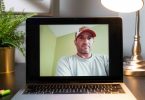Alan MacDonald (left) walks with clinical psychologist Dr. Sam Iskandar at St. John’s Rehab. (Photography by Kevin Van Paassen)
There was a time when Alan MacDonald was too traumatized to discuss some of the details surrounding the October 2018 accident that left him with severe electrical burns over 13 per cent of his body.
As part of his recovery program at Sunnybrook’s Ross Tilley Burn Centre, Alan has spent the past year in treatment with Dr. Sam Iskandar, a clinical psychologist at St. John’s Rehab.
Dr. Iskandar diagnosed him with post-traumatic stress disorder (PTSD) resulting from the event. PTSD is a condition that can cause symptoms such as recurrent flashbacks, nightmares, intrusive thoughts, extreme anxiety and depression, all manifested differently through the filter of each survivor’s individual psychology and life experiences.
Alan can now speak about his accident with an astonishing degree of openness. It’s a tribute, he says, to the work he’s done with the Sunnybrook team that took his emotional health as seriously as the repair of his body.
“You have to get to the point where the more you talk about it, the better you feel,” says the Bradford, Ont., resident.
The life-changing incident happened one morning at a strip mall in midtown Toronto. Alan, an electrician and business owner, had been called in with his team to help solve a problem resulting from a proposed electricity shutdown. A new bank branch was scheduled to go into the mall, and in order to safely install a new electrical disconnect, the power had to be shut down for four to six hours, which was not sitting well with the other mall tenants, who complained the outage would impact their businesses.
Alan agreed to inspect the site to see if they could manage the installation without shutting off the lights. Against his better judgment, he removed the electrical panel to install the new disconnect. He was alone in the room with the door closed due to the potential danger of the task.
“You have to get to the point where the more you talk about it, the better you feel.”
– Alan MacDonald on the 2018 accident that resulted in severe burns
“The next thing I knew, there was an explosion,” Alan says. “[It] knocked me into a pipe, where I hit my head pretty hard.” The culprit was a faulty disconnect, but that would only be discovered much later. At the moment, Alan had no clue what had happened and that he’d been hurt.
“I came out the door, and my guys are just staring at me; these big, broad guys were like, ‘Oh my God,’” Alan recalls. “I looked down, and my entire shirt was gone – just disintegrated. The only thing that was left was the zipper that went down halfway. The flesh was gone. My face was black. Then I had what looked like a piece of plastic stuck to my hand from the thumb down to the wrist, so I pulled it off. And that’s when I realized that wasn’t a piece of plastic. It was my skin.”
Alan’s team insisted on calling an ambulance. But Alan was in shock – he didn’t register any physical pain and, in fact, felt it was his responsibility to go right back in and fix the power outage.
He was rushed to the Ross Tilley Burn Centre. “I got in the ambulance and closed my eyes,” he says. “When I woke up, I was in a hospital room, and the doctor told me I was going to be okay.”
The surgical team treating Alan at the burn centre was led by Dr. Marc Jeschke, director of the Ross Tilley Burn Centre and a highly regarded surgeon and research scientist. Dr. Jeschke assessed Alan’s injuries, which included “significant” electrical burns, corneal abrasion due to the flash, and a torn rotator cuff.
Dr. Jeschke and his team performed multiple surgeries and skin grafts to repair the damage to Alan’s body. Dr. Jeschke also understood the mental toll the injuries would take on Alan and his family, and so he built a recovery program that went beyond the physical.
“Mental health is still completely under-appreciated,” says Dr. Jeschke. “I think that that’s something to emphasize – we are lucky we have access to psychiatry at Sunnybrook, and that we have access to psychology and psychiatry at St. John’s Rehab.”
Alan was referred to the in-patient burn rehabilitation program at St. John’s Rehab, the only such program in Canada. Its holistic approach to healing the mind, body and spirit has brought the centre international acclaim.
At St. John’s Rehab, survivors of burns, amputations and other grievous injuries have access to resources, including occupational therapy, clinical psychology and massage, that are critical to recovery. Alan worked with Dr. Iskandar, in addition to his own psychiatrist, to help him through the stages of emotional recovery and to adjust to his new life.
One of Dr. Iskandar’s main therapeutic tasks was to prevent Alan from slipping into long-term depression. He says that in many cases, even well-meaning people tend to focus on the fact that someone has physically survived a major physical trauma and are surprised to see that the person has become more taciturn and withdrawn.
“People with PTSD will continue to try and avoid people and situations that remind them of their trauma. In the case of burn injuries, that can be a barbecue, a cigarette, people associated with the event,” Dr. Iskandar says. “And then the more they avoid, the less fulfilling their life becomes, and the more depressed they may feel.”
Dr. Iskandar points out that a major injury can also have a significant impact on the survivor’s family. Someone with PTSD may not have the same capacity to deal with the daily stressors of parenting and relationships that they did before their injury, and the requirements for their care can be emotionally and physically draining for family members.
Alan says his wife, Tara, has been his “rock,” and that his three daughters have been immensely strong and supportive. But the year has brought its share of challenges at home. Once the “life of the party,” Alan became more withdrawn and occasionally angry. In March 2019, Alan spiralled into a depression while coming off his pain medications. He also experienced some mental health challenges months later, following surgery on his shoulder.
These types of setbacks are not uncommon on the road to recovery from traumatic injuries. But Dr. Iskandar notes that to the people directly affected, they can be overwhelming and trigger fear that it will be like this for the rest of their lives.
At Dr. Iskandar’s suggestion, Alan and Tara have sought out family counselling, and both are doing well. At some point in the future, Alan is planning to return to work. He says the care he has received at the Ross Tilley Burn Centre and St. John’s Rehab has given him a good shot at resuming a full life again.
“The team at Sunnybrook was just incredibly helpful,” Alan says. “The support you get there really, really makes you feel like you’re on the right track, like you’re on the road to recovery.”








